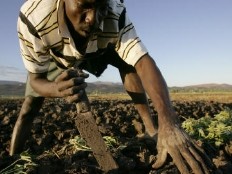|
||||||||||||||||||
|
|
Haiti - Agriculture : Update on the food safety until December 2011 28/08/2011 13:32:03
The spring harvest remains generally weak throughout almost all regions of the country due to drought occurred between March and June. Compared to the last five yearsthis situation has led to a low availability of local food products in the areas most affected like the departments of the Southeast (Cotes de fer, Grand‐Gosier and Anse‐à‐Pitres), of Northwest (Baie de Henne, Bombardopolis), of North (Bahon, Pignon, and Ranquitte), and of Northeast (Ferrier, Fort Liberté, Terrier‐Rouge, Caracol), particularly in August and September. In southern regions where planting of spring were partially successful, the prices of local food such as corn are downward. For example, the region of Les Cayes, regarded as one of the largest producing areas of corn, the pot of 6 pounds increased from 68 grours in July to 50 gourds at the beginning of August. Black beans have decreased in the Gonaives region, but up in the region of Les Cayes and Grand Anse because of the current planting in the wet hills. Imported products such as rice and corn are rising in most markets. This price increase is a transmission of prices of these products on the global market, and the decline in the volume imported. If the trend of rice prices continues, it could worsen food insecurity in the country in the coming months given that rice is the staple food of the population. With this increase in the price of rice and other basic products such as sugar, the purchasing power of the poor continue to decline. According to the Haitian Institute of Statistics and Informatics, the inflation rate year on year approaches 10%. In addition, the local currency, the gourd, depreciates against the dollar. This will cause an appreciation of the cost of imported goods including food products for which approximately 50% of the population's needs are imported. However, there is an increase in the amount of remittances from the diaspora to the country. 80 million in June 2010, the amount was increased to 88 million in June 2011, an increase of 9%. Update of the projections of food security until December 2011 : Northwest : Late plantings made in June are promising in the municipalities of the western point of the department. The crop will begin in mid-September. Due to persistent drought over the past three seasons and the loss of crops, the poor will remain in crisis (Phase 3) in August and September in the municipalities of Baie de Henne and Bombardopolis. Between October and December the situation will improve and the poor will go to Phase 2. In the eastern part of the department, the situation is much better, but still below the normal. Northeast : If the rains have favored the development of crops in the humid mountains, the drought has caused their loss to Ferrié, Fort Liberté (with the exception of the plain of Maribaroux), Terrier Rouge, Caracol and Trou-du-Nord extending the period of junction, usually ending in June. Starting in July, in the plain area in monoculture, rice fields are growing thanks to the rise of water level in rivers and lagoons. Prices are stable but higher than in July 2010. The majority of the poor will remain in precariousness (Phase 2) in August and September. With the expected harvest of mountain wetlands, a slight improvement in the situation can take place between October and December. The proximity to the Dominican Republic offers ponctual job opportunities and income in the market days [Monday to Friday] to thousands of people crossing the border. North : Almost the entire northern region was hit by the drought that delayed planting of spring : the latter have been initiated in June with the arrival of rains. The zones considered arid like Bahon, Ranquitte and Pignon were most affected. The poor are moving to the Dominican Republic or in the municipalities of Quartier Morin and Limonade in search of work. They are mostly in crisis (Phase 3), but with crops of maize and sorghum which are scheduled between late September and October, the food situation will improve. They will be in Phase 2 between October and December. Southeast : The South East has also suffered from drought during the planting season from March to June. Losses of maize and beans are estimated to about 50% in most production areas. Grand-Gosier, Anse à Pitre and Côtes-de-Fer are the most affected municipalities. The bean is the main source of income for farmers of Anse-à-Pitre and Grand Gosier. The loss of the crop valued at more than 30% in the past two municipalities reduces the access to basic foodstuffs for the poor. In addition, the region of Côtes-de-Fer was hit by the storm Emilie which damaged the fruit production (avocado and arbres véritables). The poor in these municipalities will be in crisis during the months of August and September, but could see their situation improved from October to December [in the absence of climate problem] in favor of bean crops and other crops sown in July and August to Belle-Anse and Anse-à-Pitre. However Côtes‐de‐Fer will continue to be in crisis until the end of December when the harvest of sorghum and pigeon peas will begin. HL/ HaitiLibre
|
|
|
Why HaitiLibre ? |
Contact us |
Français
Copyright © 2010 - 2024 Haitilibre.com |



